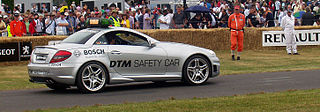 W
WThe halo is a driver crash-protection system used in open-wheel racing series, which consists of a curved bar placed to protect the driver's head.
 W
WOn 11 June 1955, a major crash occurred during the 24 Hours of Le Mans motor race at Circuit de la Sarthe in Le Mans, France. Large pieces of debris flew into the crowd, killing 83 spectators and French driver Pierre Bouillin and injuring nearly 180 more. It was the most catastrophic crash in motorsport history, and it prompted Mercedes-Benz to retire from motor racing until 1989. The crash started when Jaguar driver Mike Hawthorn pulled to the right side of the track in front of Austin-Healey driver Lance Macklin and started braking for his pit stop. Macklin swerved out from behind the slowing Jaguar into the path of Levegh, who was passing on the left in his much faster Elektron magnesium-alloy bodied Mercedes-Benz 300 SLR. Levegh rear-ended Macklin at high speed, overriding Macklin's car and launching his own car through the air. Levegh's car skipped over a protective earthen berm at 200 km/h (125 mph) and made at least two impacts within the spectator area, the last of which caused it to disintegrate, throwing him onto the track where he was instantly killed, and sending large pieces of debris into the packed spectator area in front of the grandstand, including the engine block, front suspension, and bonnet. The rear of Levegh's car landed on the berm and exploded into flames.
 W
WA racing helmet is a form of protective headgear worn by racing car and rally drivers. Motor racing has long been known to be an exceptionally risky sport: sudden deceleration forces on the head can easily occur if a racing car loses control at the very high speeds of competitive motor racing or the rough terrain experienced in rallying. A risk more nearly unique to motor racing is the possibility of drastically severe burns from fuel igniting when the fuel lines or fuel tank of the vehicle are jolted sufficiently to dislodge or breach them in a situation in which the driver cannot soon enough escape from his car. This happened to world champion driver Niki Lauda at the 1976 German Grand Prix race at the Nürburgring in a crash from which he barely escaped alive.
 W
WA racing suit or racing overalls, often referred to as a fire suit due to its fire retardant properties, is clothing such as overalls worn in various forms of auto racing by racing drivers, crew members who work on the vehicles during races, track safety workers or marshals, and in some series commentators at the event.
 W
WThe Steel and Foam Energy Reduction Barrier, sometimes generically referred to as a soft wall, is a technology found on oval automobile race tracks and high speed sections of road and street tracks, intended to absorb and reduce kinetic energy during the impact of a high speed crash, and thus, lessen injuries sustained to drivers and spectators. It was designed by a team of engineers led by Dean Sicking at the Midwest Roadside Safety Facility at the University of Nebraska-Lincoln. It was developed from 1998–2002, and first installed at the Indianapolis Motor Speedway in May 2002.
 W
WIn motorsport, a safety car or pace car is a car which limits the speed of competing cars on a racetrack in the case of a caution period such as an obstruction on the track or bad weather. The aim of the safety car is to enable the clearance of any obstruction under safer conditions, especially for marshals and/or await more favourable track conditions weather-wise.
 W
WSafety in NASCAR has evolved into one of the biggest concerns in stock car racing's largest sanctioning body. Mainly after the death of Dale Earnhardt, a seven time Winston Cup Series champion, NASCAR has decided to change all of their safety policies, such as the use of the HANS device. Since 2001, NASCAR has also changed the cars for the NASCAR Cup Series and the Xfinity Series. NASCAR's safety policy includes the racing fire suit, carbon fiber seating, and roof flaps.
 W
WA zero car is a car used in rallying to open the road for the competing cars.